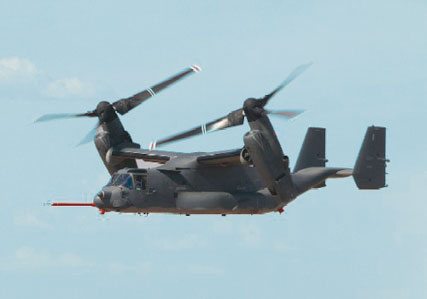Building Helicopter Prototypes with FDM
Bell Helicopter is a manufacturer of the heavy-tilt lifter “tilt-rotor” Osprey, the hybrid aircraft that features a combination of an airplane and a helicopter. This unique product is capable of lifting off, hovering, and vertically landing while being able to cruise at high altitudes at jet speeds. When the aircraft was due for an upgrade, the technicians at Bell adopted a Fortus 3D Printer to build tough polycarbonate wiring conduits.
“We built the conduit for one stabilizer, and the development team installed it on the mock-up. It was successful so they immediately requested a second set for the other stabilizer,” says RP lab technician Mike Storp. After some minor variations the team requested five more complete sets for a total of 42 conduit models. “It took only two and a half days to make them all. The Fortus system ran around the clock.” The development group was pleased because Bell could keep control of the project in-house, but also because they would have had to wait six weeks if the prototypes were made traditionally, of cast aluminum. “We obviously saved money as well,” Storp says.
Bell Helicopter chose the process due to FDM featuring PC and PPSF material options. These thermoplastics work exceptionally well for functional testing, imperative for demanding applications in the aerospace sector. PC characteristics include dimensional stability, high heat-distortion temperature, high tensile and flex strength, and a hardness exceeding that of ABS plastic. PPSF characteristics include a VØ Flammability rating, the highest impact strength of any rapid prototyping plastic, very high tensile and flex strength, dimensional stability, and resistance to petroleum products, acids, bases, and chemicals. “You’ll never see an epoxy part on an aircraft for a functional test,” says Storp. “Fuels and hydraulic fluids would actually dissolve it.”
“The efficient process allows us to do more iterations than we could with other processes. That results in better-designed components.” — Mike Storp, Bell Helicopter
Takeoff
“All processes are easy when it comes to building the part. But with some of them, you really have to stay on top of it after the part is built. They can be very messy and time-consuming. That’s a big issue. We don’t have that hassle with FDM.”
“It takes a long time to design an aircraft. Starting from scratch it can take five years, and it’s a rigorous development process to go through,” says Storp. “When using FDM over the course of development for a new aircraft, there is great potential to reduce costs and development time.”
Those qualities make fused deposition modeling essential to the lab’s purpose, which is to contribute to aircraft prototype development and support Bell Helicopter’s long-range plan to become the heavy-lift tilt-rotor aircraft leader. “The efficient process allows us to do more iterations than we could with other processes,” Storp says. “That results in better designed components.”
